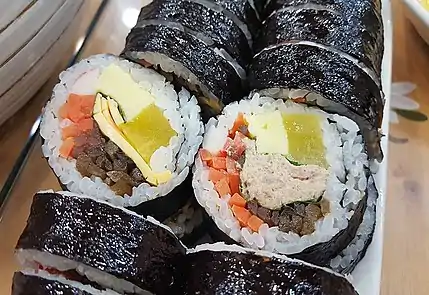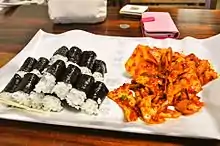Gimbap
Gimbap (김밥) is a Korean dish made from cooked rice and other ingredients that are rolled in gim—dried sheets of seaweed—and served in bite-sized slices.[1] It is not to be confused with sushi, which is from Japan. The dish is often part of a packed meal, or dosirak, to be eaten at picnics and outdoor events, and can serve as a light lunch along with danmuji (yellow pickled radish) and kimchi. It is a popular take-out food in South Korea and abroad,[2] and is known as a convenient food because of its portability.
 sliced vegetable gimbap | |
| Place of origin | |
|---|---|
| Main ingredients | Gim, bap |
| Variations | Chungmu-gimbap, samgak-gimbap |
| Similar dishes | Norimaki |
| Korean name | |
| Hangul | 김밥 |
|---|---|
| Revised Romanization | gimbap |
| McCune–Reischauer | kimbap |
| IPA | [kim.bap̚]~[kim.p͈ap̚] |
Etymology
Gim (김) refers to edible seaweed in the genus Porphyra and Pyropia. Bap (밥) broadly refers to "cooked rice". The compound term gimbap is a neologism; it was not a part of the Korean language until the modern era. Gimbap was called bokssam (복쌈; 福-) in the Joseon era (1392–1897).[3][4]
The term gimbap was used in a 1935 Korean newspaper article,[5] but at the time, the loanword norimaki was used as well. Norimaki, which borrowed from the name of a similar Japanese dish, was part of the Japanese vocabulary that entered into the Korean language during the Japanese occupation (1910–1945). The two words were used interchangeably until gimbap was made the universal term as part of efforts to clear away the remnants of Japanese colonialism and purify the Korean language.[6]
History
Production of gim in Gyeongsang and Jeolla Provinces is reported in books from the 15th century, such as Gyeongsang-do Jiriji and Sinjeung Dongguk Yeoji Seungnam.[7][8] Eating cooked rice rolled in gim is also a long-standing Korean custom. Yeoryang Sesigi, a book from the Joseon period (1392–1897), refers to kimbap as bokssam (복쌈; transcribed using the hanja 縛占, pronounced bakjeom in Korean).[3][4]
There are several conflicting versions of the origin of the modern form of gimbap. Some Japanese nationalists claim it was derived from norimaki, a Japanese sushi variant. Norimaki was invented in the Edo era and noted in 1716.[9] [10]Japan introduced the word norimaki to Korea during the Japanese occupation.[11][12][13] Other sources say Koreans introduced the concept to Japan during the Baekjae period (18 BC – 660 AD).[14][15] The most accepted theory among historians is that the food was developed from the long-established local tradition of rolling bap (cooked rice) and banchan (side dishes) in gim.[4][16]
Gimbap and norimaki now refer to distinct dishes in Japan and Korea: the former called kimupapu (キムパプ) in Japanese and the latter called gimchobap (김초밥; "gim sushi") or norimaki (노리마키) in Korean. Gimbap is usually rolled with several ingredients and is seasoned with sesame oil, while norimaki is usually rolled with one ingredient and is seasoned with rice vinegar.
Ingredients and preparation
Gim and bap are the two basic components of gimbap. While short-grain white rice is most commonly used, short-grain brown rice, black rice, or other grains may also serve as the filling.
Some varieties of gimbap include cheese, spicy cooked squid, kimchi, luncheon meat, or spicy tuna. The gim may be brushed with sesame oil or sprinkled with sesame seeds. In one variation, sliced pieces of gimbap may be lightly fried with an egg coating.
Fillings vary, often with vegetarian and vegan options.[17] Popular ingredients include danmuji (yellow pickled radish), ham, beef, imitation crab meat, egg strips, kimchi, bulgogi, spinach, carrot, burdock root, cucumber, canned tuna, and kkaennip (perilla leaves).
To make the dish, gim sheets are toasted over a low heat, cooked rice is lightly seasoned with salt and sesame oil, and vegetable and meat ingredients are seasoned and stir-fried or pan-fried. The toasted gim is then laid on a gimbal—a bamboo gimbap roller—with a thin layer of cooked rice placed evenly on top. Other ingredients are placed on the rice and rolled into a cylindrical shape, typically 3–4 centimetres (1.2–1.6 in) in diameter. The rolled gimbap is then sliced into bite-sized pieces.[18]
Variants
- Chungmu-gimbap (충무김밥) – Originating from the seaside city of Chungmu (currently Tongyeong), the dish features thinner rolls with an unseasoned surface and only rice as the filler ingredient. It is served with spicy ojingeo-muchim (squid salad) and seokbakji (radish kimchi).[19]
- Mayak-gimbap (마약김밥) – A specialty of Gwangjang Market in Seoul. Mayak translates as "drug", a reference to its allegedly addictive and concentrated flavour. Small gimbap filled with carrots, spinach, and danmuji (yellow pickled radish) is sprinkled with ground sesame seeds and dipped in its pairing sauce made from soy sauce and mustard.
- Samgak-gimbap (삼각김밥) – Literally "triangle gimbap". This variety is similar to Japanese onigiri, and is sold in convenience stores in South Korea.[20] Fillings vary greatly. The expiration date is 1 day, and has a calorific value of between 140 and 200 kilo calories usually.[21]
- nude gimbap – Unlike ordinary gimbap, the ingredients of the gimbap go inwards, and the rice comes out and covers the entire area. It is similar to Japanese style rolls, but uses ingredients used in Korean-style kimbap (hams, meat fillets, pickled radish, spinach, etc.) and is also served with cheese or sauce.
Restaurant franchises
Many South Korean fast food restaurant franchises specialize in gimbap and noodles. Among the chains are Gimbap Cheonguk (김밥천국), Kobongmin Gimbabin (고봉민김밥人), Chungmu Gimbab Matjuk (충무김밥죽), Teacher Kim (바르다김선생), Gimbap Nara (김밥나라), Gimgane (김家네), Gobong Gimbap (고봉김밥), Jongro Gimbap (종로김밥), Rolling Rice, Gimbap King (김밥 King), and Charles Sutbul Gimbap (찰스숯불김밥).[22] Some of these restaurants also serve other dishes, including dongaseu (pork cutlet), ramyeon (instant noodles), udong (thick noodle soup), naengmyeon (cold noodles), bibimbap, and stews such as kimchi-jjigae (kimchi stew), doenjang-jjigae (soybean paste stew), sundubu-jjigae (soft tofu stew), and omurice.
Cultural signifier of poverty
Gimbap is generally sold, pre-cut, in restaurants. However, due to the negative stigma surrounding begging, unskilled public busking and prostitution (illegal in South Korea), selling whole gimbap as a street vendor is seen as the final noble and dignified form of busking that an otherwise able person, or family members of affected people, can do to get out of poverty. This is because virtually everybody can make this, and it is much more cost and time effective, and less labour-intensive, than making kimchi or preserved fruits. Vendors often sell and eat gimbap as an entire log, even after they are out of poverty or emergency. Selling whole also extends shelf life, and signifies longevity. [23]
See also
References
- National Institute of Korean Language (30 July 2014). "주요 한식명(200개) 로마자 표기 및 번역(영, 중, 일) 표준안" (PDF) (in Korean). Retrieved 15 February 2017. Lay summary – National Institute of Korean Language.
- Alexander, Stian (21 January 2016). "UK's new favourite takeaway has been revealed - and it's not what you'd think". Daily Mirror. Retrieved 26 February 2017.
- Kim, Maesun (1819). Yeoryang Sesigi 열양세시기(洌陽歲時記) [Records of Seasonal Festivities around the Capital]. Joseon Korea.
- 박, 정배 (12 October 2016). "1819년엔 '福쌈'이라 불려… 이젠 프리미엄 김밥도". The Chosun Ilbo (in Korean). Retrieved 26 February 2017.
- "휴지통". The Dong-a Ilbo (in Korean). 14 January 1935. Retrieved 26 February 2017 – via Naver.
문어 점복에 김밥을 싸먹고 목욕한후 바위등에 누으면 얼화만수——
- "노리마키(海苔卷)". National Institute of Korean Language (in Korean). Retrieved 27 February 2017.
- Ha, Yeon; Geum, Yu; Gim, Bin (1425). Gyeongsang-do Jiriji 경상도지리지(慶尙道地理志) [Geography of Gyeongsang Province] (in Korean). Joseon Korea.
- Yi, Haeng (1530) [1481]. Sinjeung Dongguk Yeoji Seungnam 신증동국여지승람(新增東國輿地勝覽) [Revised and Augmented Survey of the Geography of Korea]. Joseon Korea.
- 料理山海郷"Ryori Sankai kyo". Edo,Japan: 中川/藤四郎〈京〉,中川/新七〈京〉. 1750.
- "料理山海郷 - 国立情報学研究所".
- 文化体育観光部 文化ストーリーテリング 김밥
- 国立国語院編集 (2006). 韓国伝統文化事典. Translated by 趙完済, 三橋広夫和書. 教育出版. ISBN 978-4316801032.
- 鄭銀淑 (2007). 韓国・下町人情紀行. 朝日新書和書. 朝日新聞社. ISBN 978-4022731500.
- Levinson, David; Christensen, Karen, eds. (2002). Encyclopedia of Modern Asia. 2. Charles Scribner's Sons. p. 203. ISBN 9780684312439.
- The National Academy of the Korean Language, ed. (2002). Uri munhwa gillajabi 우리 문화 길라잡이 [An Illustrated Guide to Korean Culture] (in Korean). Seoul: Hakgojae. ISBN 9788985846974.
- 김, 춘련 (18 August 2015). "gimbap" 김밥. Encyclopedia of Korean Culture (in Korean). Archived from the original on 25 March 2012. Retrieved 26 February 2017.
- Goldberg, Lina (23 March 2012). "Asia's 10 greatest street food cities". CNN. Retrieved 11 April 2012.
- "gimbap" 김밥. Korean Food Foundation. Retrieved 22 April 2017.
- "Chungmu-gimbap" 충무김밥. Doopedia (in Korean). Doosan Corporation. Retrieved 19 May 2017.
- Choi, Hyun-joo (18 May 2017). "Republic of convenience stores". Korea JoongAng Daily. Retrieved 19 May 2017.
- "삼각김밥", 위키백과, 우리 모두의 백과사전 (in Korean), 2018-07-24, retrieved 2019-03-18
- 이, 창선 (5 December 2016). "[김밥 프랜차이즈 브랜드평판] 1위 김밥천국, 2위 고봉민김밥인, 3위 충무김밥". The Korea Financial Times (in Korean). Retrieved 20 May 2017.
- Yena and Sad Gimbap Story [IZ*ONE CHU EP. 4], retrieved 2020-06-13


.jpg.webp)
_2.jpg.webp)
_3.jpg.webp)
